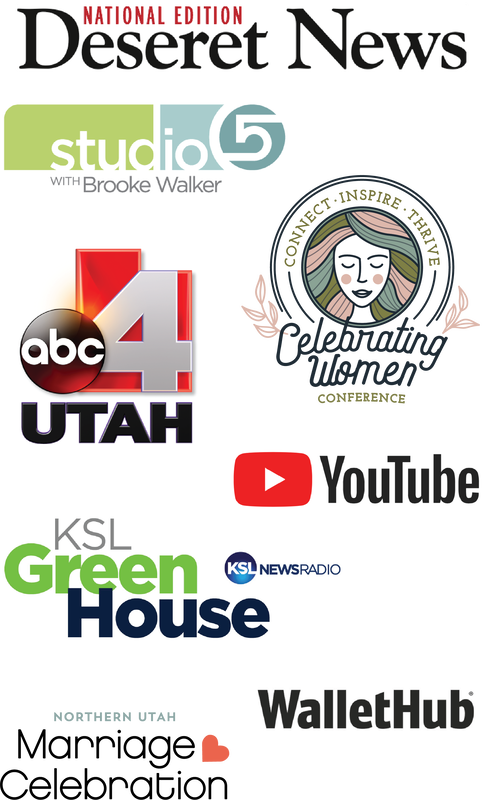|
Melanie Jewkes, M.S. USU Extension Associate Professor  Now that the holidays are behind us, you may or may not be a little anxious to peek at your bank or credit card statements. No surprise when Americans purchase about $1,000 worth of holiday joys on credit. But now might be the perfect time of year to make a better plan for next year. There is a better way! My favorite budgeting magic trick is to avoid using debt or credit, especially for small purchases but also for larger ones, buy paying yourself first. Maybe you’ve heard that phrase before “Pay yourself first.” This is a seemingly simple principle to encourage use of cash instead of borrowing. In other words-- save money and avoid debt so that instead of paying somebody to use their money (i.e. money you have to pay on interest and late fees or even loan origination fees), you “pay” yourself by putting that money into savings. In some instances you earn money on interest (though, admittedly, the interest rates right now on bank accounts is minimal) or at least avoid paying more than the cost of whatever the item was you charged. Pay Yourself First also applies to long-term savings for things like retirement, but for now we’re talking about “small” purchases that can sometimes irritate, if not wreak havoc, on our monthly budgets. Let’s talk more about the real, life-changing application of this principle and how to apply it. Avoid paying others to use their money. If I charge $1,000 for all my holiday shopping and allow that balance to carry forward, that balance will start to be charged interest -- and credit cards are not known for low interest rates. In one month, I could pay 15% in interest. One month might not seem that bad, but if I pay only a $40 minimum balance, it will take me 66 months (over 5 years) to pay it off, and over the life of that holiday shopping balance, I will pay $361 in interest, making the original charge of $1,000 turn into $1,361.
Keep your money to yourself -- Pay Yourself First. By paying yourself first, you can keep that $361 all to yourself! Yes, please! Here’s how I pay myself first for such charges as the holidays. In the month of December alone, I need to pay for two car registration fees (plus their safety and emissions tests), all the many christmas expenses I have, including hosting holiday parties (not this year, no thanks to COVID), my birthday and often expensive race registration fees for my husband’s hobby. That’s too many expenses for my monthly income to handle by itself. Instead, I rely on paying myself first all year long. I do this by putting a portion of my monthly income into a separate savings account -- whose only purpose is to hold it until I need to make these expenses. I call it my “revolving savings” account -- because my money goes in and out of it often (revolves). Others call it their “special expenses” account -- which covers short term goals and/or these irregular expenses. Without this account, these larger expenses would otherwise break my December budget. How to set up a Special Expenses account to Pay Yourself First Step 1: Make a list. First, I started with a simple pen and paper and listed the expenses I know are coming throughout the year that don’t happen each month. This list gets added to my budgeting spreadsheet as a separate tab. Here are some expenses I include, in addition to those I mentioned above:
My list has grown over the years! I love that this savings allows me to pay cash for each of these expenses. Step 2: Make note of the cost of each expense. List how much each of those expenses cost in the past, or how much you’d like to spend in the future. Click below for a template you can use, or make your own! Template 1; Template 2. Step 3: Figure out your monthly Pay Yourself First amount. To figure that out, add all of those expenses together in one big lump sum. Then divide by 12 months (or by how many paychecks you have in a year--whichever is easier for you to set up how much to take from each paycheck). This is your monthly total to set aside for these irregular or special expenses. Step 4: Set up an automatic transfer. Set up an automatic recurring transfer from your paycheck, or from your bank account, into another sub-account with your bank (or open a new one). Once in a separate account, you now have that money waiting for you to spend! And as the next Christmas approaches, you will have CASH and won’t feel the need to charge those expenses. Start Paying Yourself First NOW. Now is the perfect time to start! Dare to peek at that credit or bank account statement and figure out how much you spent on the holidays. Divide that by 12 to figure out how much to save for next Christmas. By the time December rolls around next year, you’ll have a nice little stash of savings for you to spend. If you are loving this idea but are overwhelmed by that monthly savings number of adding all of your yearly expenses together, start with just a few. You don’t have to go as specific as I did -- maybe it is easier to take Easter basket candy out of your miscellaneous budget line in your monthly budget. Another tip is to use some of your tax return as a jump-start to this special savings account. I also use the Pay Yourself First principle to save for a car. I pay myself a car payment every month to save for a car so I don’t need to use a car loan. Due to a couple of car accidents that have totaled our cars within the last 1-5 years, I have used my car fund to pay for vehicles. I love to see the look on the faces of the car salesman when they learn that! What is your motivation for paying yourself first?
0 Comments
Your comment will be posted after it is approved.
Leave a Reply. |
TAKE A FREE CLASS!Host a ClassamandaSharing real-life money smarts to help you stay on track with financial goals while still enjoying life! Follow the fun on InstagramAS SEEN ONawardsBest of State 2022 & 2023: Personal Finance Education
1st Place National Award in Social Media Education from the National Extension Association of Family and Consumer Sciences
Gold Award in Blog Site category at the 7th annual Education Digital Marketing Awards.
Platinum Award in Digital Media, Web Design category at the International Marketing and Communication Awards.
Categories
All
|








